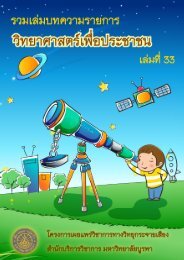USER MANUAL SWAN Cycle III version 40.72A
USER MANUAL SWAN Cycle III version 40.72A
USER MANUAL SWAN Cycle III version 40.72A
You also want an ePaper? Increase the reach of your titles
YUMPU automatically turns print PDFs into web optimized ePapers that Google loves.
Definitions of variables 91<br />
RPER<br />
command. If p = 1 (the default value) PER is identical to TM01 and<br />
if p = 0, PER = TMM10.<br />
Average relative period (in s), defined as<br />
∫ ∫ σ<br />
RT m,p−1,p = 2π<br />
p−1 E(σ,θ)dσdθ<br />
∫ ∫ σ p E(σ,θ)dσdθ<br />
FSPR<br />
Here, if p = 1, RPER=RTM01 and if p = 0, RPER=RTMM10.<br />
The normalized frequency width of the spectrum (frequency spreading),<br />
as defined by Battjes and Van Vledder (1984):<br />
FSPR = |∫ ∞<br />
E(ω)e iωτ dω|<br />
0<br />
E tot<br />
, for τ = T m02<br />
DSPR<br />
The one-sided directional width of the spectrum (directional spreading<br />
or directional standard deviation,in o ), defined as<br />
DSPR 2 = ( 180<br />
π<br />
) 2 ∫ 2π<br />
0 (2 sin(θ−θ<br />
2 ))2 D(θ)dθ<br />
and computed as conventionally for pitch-and-roll buoy data<br />
(Kuik et al. (1988); this is the standard definition for WAVEC buoys<br />
integrated over all frequencies):<br />
⎛<br />
(∫ )<br />
(DSPR π<br />
√<br />
2 (∫ ) ]<br />
180 )2 = 2 ⎝1 − √[ ⎞ 2 sin<br />
∫ θE(σ,θ)dσdθ cos θE(σ,θ)dσdθ<br />
E(σ)dσ<br />
+ ∫ ⎠<br />
E(σ)dσ<br />
QP<br />
The peakedness of the wave spectrum, defined as<br />
∫ ∫ σE<br />
Q p = 2 ∫ ∫ 2 (σ,θ)dσdθ<br />
( E(σ,θ)dσdθ) 2<br />
MS<br />
This quantity represents the degree of randomness of the waves.<br />
A smaller value of Q p indicates a wider spectrum and thus<br />
increased the degree of randomness (e.g., shorter wave groups),<br />
whereas a larger value indicates a narrower spectrum and a more<br />
organised wave field (e.g., longer wave groups).<br />
As input to <strong>SWAN</strong> with the commands BOUNDPAR and BOUNDSPEC,<br />
the directional distribution of incident wave energy is given by<br />
D(θ) = A(cos θ) m for all frequencies. The parameter m<br />
is indicated as MS in <strong>SWAN</strong> and is not necessarily an integer number.<br />
This number is related to the one-sided directional spread of the waves<br />
(DSPR) as follows:




